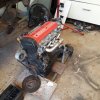Its a Toyota Starlet Factory turbo charged 1331cc motor that has been mildly tweaked to deliver a modest 180bhp.
EP82? Starting from 133hp, not bad.
4E-FTE
The first generation of the
4E-FE was the basis of the 4E-FTE in 1989, which is a
turbocharged engine producing 133 hp (99 kW; 135 PS) at 6,400 rpm with 116 lb⋅ft (157 N⋅m) of torque at 4,800 rpm. The 4E-FTE is the most powerful of the E series engines ever produced. It was produced exclusively for the Toyota Starlet GT Turbo (Japan Only) and its successor, the Toyota Glanza V (Japan only). However the 4E-FTE was a very popular conversion engine by enthusiasts for many small Toyota cars such as the Corolla, Tercel, Paseo and Sera which it fit into with standard Toyota parts. The 4E-FTE differs internally from the 4E-FE with its stronger connecting rods, lower compression pistons (reduced from 9.6:1 to 8.5:1) and stronger crankshaft. The cylinder head and valve train are identical to the 4E-FE. The 4E-FTE also features a harmonic damper instead of a normal crankshaft pulley. The turbocharger fitted to the 4E-FTE was Toyota's own CT9 model, which features an internal waste gate and has two modes: low 0.4 bar (5.8 psi) and high 0.65 bar (9.4 psi) boost. The low boost mode is electronically controlled by a solenoid valve and the
ECU and the high boost is controlled by an actuator connected to the turbocharger. The 4E-FTE also has a top-mounted, air-cooled
intercooler. The 4E-FTE is mated to the Toyota C52 transmission (for the EP82 Starlet GT) and the C56 transmission (for the EP91 Glanza V).
Specs
- Bore x stroke 74 mm × 77.4 mm (2.91 in × 3.05 in)
- 8.5:1 compression ratio
I recall another forum member using this set up a long while ago, there were questions about the intercooler on top of the transmission area getting enough air.
It would be great to see more details.
Thanks
Karl

